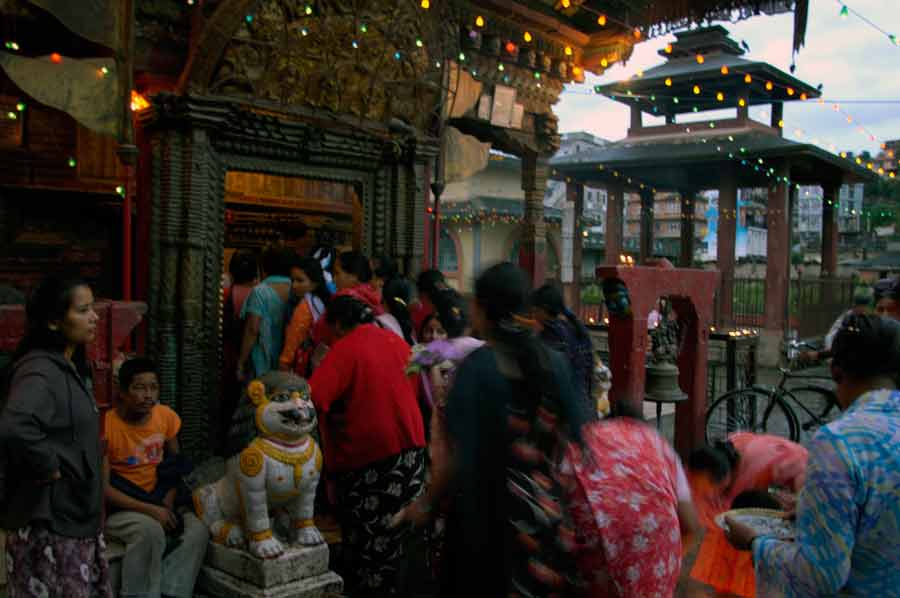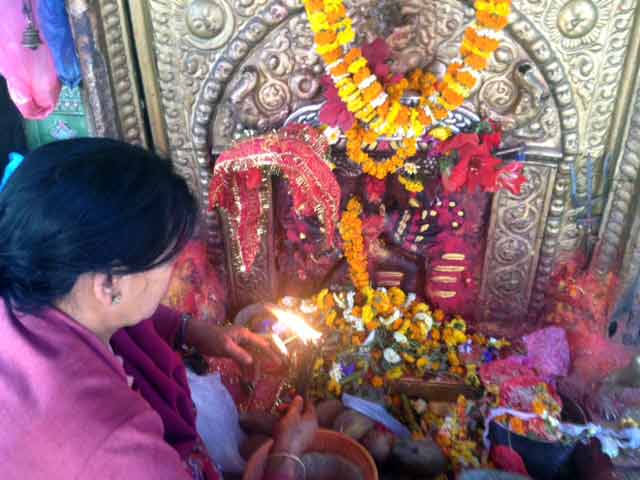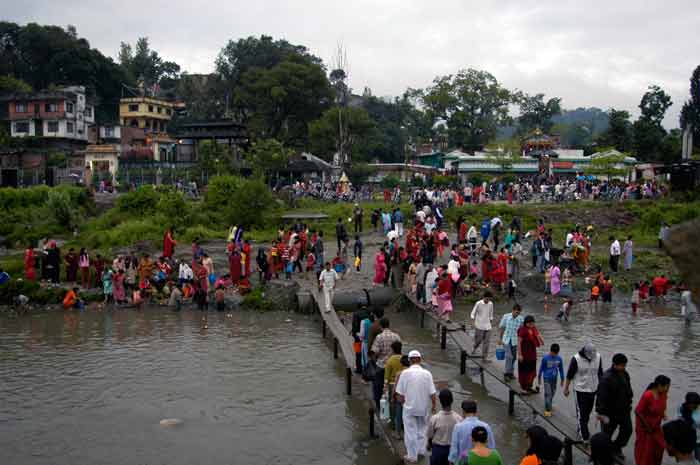
Indrayani Matrika Temple,KTM photo by L. Amazzone
Editor’s Note:
This is the excerpt from Laura Amazzone's Goddess Durga and Sacred Female Power, the book that explores the many faces of the Goddess Durga in ancient and contemporary culture, via exploration of Her mythology, rituals, philosophy, and spiritual practices. This distinctly female-centered and millennia-old tradition of Durga offer an alternative model of female potential and empowerment, focusing on peace, healing, spiritual liberation, and realization of inherent divinity.
Pilgrimage has been an enduring expression of reverence and devotion within spiritual and religious traditions since earliest times. Within the Hindu tradition, it is called tīrtha-yātrā, which literally means “undertaking a journey to river fords.”[1] Rivers and fords are considered natural places
imbued with much power. Groves, caves, hilltops and mountain peaks are other equally important places of worship, especially in Goddess cultures around the
world. Many of the most potent Goddess sites in the Hindu and Buddhist tradition can be found at places within the natural landscape. We can consider all
of South Asia in the following statement: “The number of Hindu sanctuaries in (India) is so large and the practice of pilgrimage so ubiquitous that the
whole of (India) can be regarded as a vast sacred space organized into a system of pilgrimage centers and fields.”[2] While some places may be the
focal point for Hindus or Buddhists all over South Asia, others may be more local and attract the visitation of that area’s inhabitants. Regardless of
whether pilgrims travel thousands of miles or a few footsteps, these sacred places are repositories of spiritual and religious knowledge and ritual
tradition.
Pilgrimage means to “partake of a shrine”; however, the “shrine” can also be a quality of truth in addition to and sometimes instead of a physical place.
Pilgrimage can be understood metaphorically, and the journey can equally be an inner one that takes place during meditative practices. The tīrtha
or “ford/crossing” can refer to qualities we mentally invoke such as kindness, devotion, compassion, and presence to deal with our struggles and conflicts.
In this sense we must cross over the obstacles in the mind that prevent us from achieving our goals and focus on cultivating purer states of awareness.
From a religious perspective, pilgrimages are performed to purify the soul and to help us obtain specific goals within the mundane world. According to
Surinder Mohan Bhardwaj, author of Hindu Places of Pilgrimage in India, there are two main categories of intention in a pilgrimage. The first
involves a specific and more mundane motive. It usually includes prayers for a blessing, help, success or protection. It can also involve a specific rite
of passage such as a child’s first haircut, menstruation, pregnancy or birthing rites. Other societal passages from childhood into adulthood or any
experience where one undergoes deep transformation and wishes to mark their crossing over into the next stage of being or life are valid reasons for
physically or metaphorically undertaking a pilgrimage. Often vows (sukhnā or vrata) are made to help focus the pilgrim’s intention and to strengthen their
commitment toward achieving the desired result. Sacrifices, both monetary and animal, are another way they expresses their vows.

Shobbhagawati Temple.photo by L. Amazzone
The second category of intention does not involve mundane requests or rewards, but focuses on achieving religious or spiritual merit and alleviating the
effects of our karma. Karma is a complex system that goes beyond its popularized and generalized meaning of cause and effect. Sometimes the pilgrim
participates to lessen the effects of karma s/he is experiencing. Others may go purely to express and deepen their reverence and devotion to a deity or
their religious path. While some pilgrims may perform or participate in certain rites or ceremonies, these rituals are not always necessary for a
successful journey. Often darśan (the act of seeing and being seen by the deity) is the most salient goal for the pilgrim. Darśan is a central
ritual concept, especially within Tantra. Darśan focuses on the relationship between devotee and the Divine. It refers to the exchange of energy between
them that is sometimes the most desired and ultimately transformative experience. Diana Eck illuminates the deep significance of darśan in her book, Darśan: Seeing the Divine Image in India. Eck explains,
The pilgrims who take to the road on foot, or who crowd into buses and trains, are not merely sightseers, but “sacred sightseers” whose interest is not in
the picturesque place, but in the powerful place where darśan may be had. These powerful places are called tīrthas (sacred “fords” or “crossings”), dhāms
(divine “abodes”), or pītha (the “benches” or “seats” of the divine).[3]
In addition to darśan there are many other ritualistic means to pay homage on a pilgrimage: bathing in a tīrtha, sacred river, lake, or pond; giving alms;
singing bhajans, devotional songs to the deity; or kirtan, group devotional expression through song and dance, as well as other rites that relate more
specifically to the deity or place the pilgrim is visiting. “For the pilgrims a whole cosmic event is being reenacted, one in which they actually
feel they are participating. The myth is re-actualized, at the specific time and at the specific place.”[4]
Pilgrimage leads us toward self-realization and spiritual liberation. For orthodox Hindus spiritual liberation means transcending this earthly reality and
breaking free from the cycles of karma that bind us to this world. For the Tantrika (Tantric practitioner), freeing ourselves from karma is essential;
however leaving this body and world is not the ultimate goal. From the Tantric perspective, the Divinity is immanent as well as transcendent. Instead of
trying to escape this existence, engaging with the world around us in all its beauty and all its horror is crucial to the Tantric path. For a Tantrika, the
body is a vehicle and the senses are utilized rather than denied. Therefore, pilgrimage is an effective way for the practitioner to earn religious merit.
Achieving such merit will ultimately bring improvement to this life and future ones, should the soul not achieve full spiritual emancipation in this
lifetime. Regardless of sectarian affiliation within the Hindu or Buddhist traditions, there are various paths one can follow: jñāna yoga (the path of
knowledge), karma yoga (the path of action), rajas yoga (the path of passion), and bhakti yoga (the path of devotion). My own personal quests tend to
involve bhakti, the devotional aspect, most strongly; however, jñāna, knowledge, has been a salient path for me as well.
Traveling to sacred places with a devotional intention or specific request allows the pilgrim to step away from the responsibilities, stresses, concerns
and problems of everyday life. S/he has an opportunity to fully immerse themselves in spiritual contemplation and prayer. Such periods can prove
rejuvenating for the practitioner, enabling her to return to her daily life with renewed clarity and strength, even with insights into solutions to
problems or difficulties that may have been limiting her.
In order to fulfill one’s spiritual destiny there are various paths the practitioner can follow. The practice of pilgrimage follows four dominant ideas
within Hindu philosophy that are attributed to attitudes towards life: dharma (work, duty, virtue), artha (material gain, worldly advantage, success), kāma
(love, pleasure, desire) and mokṣa (liberation). For orthodox practitioners dharma, artha and kāma all lead one to the final stage of
liberation—mokṣa, which will hopefully lead one into spiritual bliss and enlightenment. For unorthodox practitioners, for example Yoginīs and Yogis, an
unconventional path may be chosen, one that will lead them directly to the final stage so that they can spend their life cultivating and expressing
qualities that lead them to mokṣa. All rites and rituals help one liberate oneself from the bondage of thoughts and actions that keep one caught up in the
endless cycle of death and rebirth.

River crossing to Shova Bhagawati Temple.KTM. photo by L. Amazzone
Navarātri—Nine Nights, Durgā Pūjā
Each year millions participate in the annual Durgā Pūjā, the largest contemporary Goddess festival on the planet, and pay homage to Durgā . In the
Kathmandu Valley there are nine tīrthas (fords/crossings) that form a pilgrimage route for the festival in the Valley. Each of these sacred places is
associated with a body of water in which the pilgrim could take a ritual bath before the sacred rites. However, today, the water near the majority of these
places has unfortunately become too polluted for bathing. Instead of bathing near each respective site, many pilgrims perform such rituals at home, or at
the tīrtha near the Shob Bhagawatī temple—an important temple site during the festival. Rather than rules being rigid about how and where one should
worship, devotees do adapt with the times and shifting landscape. Certain ritualistic aspects are important, but there is some flexibility especially in
the Valley, which houses people from various ethnic backgrounds and animist, Buddhist and Hindu beliefs. Let’s consider why the Durgā Pūjā serves as one of
the largest pilgrimage experiences within the South Asian world. What purposes does it serve and what does it have to offer not only those in the East, but
others, like myself, who are not Hindu by birth?
Celebration of Durgā’s victory over the buffalo-headed demon takes place all over the South Asian subcontinent as well as other parts of the Hindu world
each fall. Despite the universality of worship of the Divine as Goddess, the length and some aspects of this three-to-ten-day ritual vary depending on
region. The recitation of the Devī Māhātmya or Śrī Śrī Caṇḍī text that narrates Durgā’s victory over the demons in three stories or
caritas is a common element of worship and practice throughout the Hindu World. The Caṇḍī serves as a mythological guide demonstrating the
immeasurable powers Durgā embodies, which, from a Tantric perspective, are inherent in each of us. Durgā’s name “may denote worldly adversity (e.g.
dangerous passages) or an unassailable fortification. Devī thus aids one in overcoming difficulties and traversing hardships, or is herself an impenetrable
mystery and difficult to overcome.”[5]
Durgā is called because earthly existence has reached a critical juncture. She is invoked to restore balance to the earth and to help us enter into the
natural decaying and dying aspect of the yearly, even cosmic cycle. Images of death appear all around us—in the media, in film. We hear stories of torture
and war; patriarchal man-inflicted causes of violence and death. Images of death from unnatural and violent causes have become so prevalent most of us have
become desensitized and cannot see how it is rupturing the natural web of existence. To speak of death is taboo, and, in fact, it is feared by all of us.
And yet to a Tantrika or Yoginī, our entire lives are a great preparation for death. Undertaking a pilgrimage is a very effective way for us to confront
this natural aspect of the life cycle. There is always something passing away in our lives—at every moment we experience loss.
In Hinduism we find reverence for the full cycle of existence and practices that guide us to focus on our breath—each breath out, a mini-death, each breath
in, an affirmation of life. Buddhism also speaks of the impermanence of existence. In the earth-based roots of every religion we find an understanding of
the complementary reality of death. Traveling to sacred sites can serve to amplify the ever-present reality of death through various expressions that are
personal to each of us. Pilgrimage provides us with an opportunity to learn to see and to honor the patterns of death in our daily lives as much as we love
and honor the birth and fruition stages. Death in the literal sense is also a motive for pilgrims, especially in regards to religious and ceremonial duties
associated with a deceased family member. When a Hindu dies, their physical body is cremated in a ritual ceremony. The consecrated ashes must be returned
to a river, a tīrtha. This practice is called muṇḍana and is an especially important practice at Goddess sites.[6]
The Durgā festival offers us an opportunity to fully participate in the mythological and philosophical aspects of the Hindu tradition. We are active
participants in the entire life cycle. We live and express the myth through ritual. When we participate in rituals, we become Her. There is a Tantric
precept that says: In order to know Goddess, one must become Goddess. When we open to Goddess, new layers of consciousness are revealed. Mystical
signs abound. We are swept up by profound feelings of devotion. Another reason to undertake a pilgrimage is so that this numinous state can be
spontaneously triggered at Her sacred sites. The devotee does not merely call for the Goddess, or ask Her to return, s/he speaks of a nearness that is
intimate, familiar and mesmerizing.
Although knowing Hindu philosophy and mythology is not necessary for reaping the benefits of the pilgrimage, such knowledge will also help us understand
our experiences and the age-old layers of meaning they contain. One striking variation between the Kathmandu Valley and Bengal, Assam, (as well as other
parts of India: Orissa and Gujarat) is the reversal of the first three days of the Pūjā. In the Devī Māhātmya text the first three pūjā days are devoted to Mahākālī and the final three to Mahāsaraswatī. In the Kathmandu Valley the first three days are devoted to
Mahāsaraswatī. I found that Saraswatī was indeed very present for me when the Durgā Pūjā began in the Kathmandu Valley. I continued to follow the rituals
and philosophies as they were expressed in Nepal without any reservation. Both systems’ approach to the cyclical nature of death and birth were evident in
the rituals. We could begin the Pūjā approaching a Goddess of death, or of birth, for in this tradition death leads to rebirth. Ultimately you cannot
separate them.
In keeping with the philosophical basis of the rituals, it is necessary to outline the powers of these three aspects of the Goddess Herself and explain how
they relate to our worldly existence and spiritual paths. While these qualities are inherent in everyday life regardless of where we are, they seem to
become heightened and more visible and tangible during spiritual festivals and rituals. Inevitably any pilgrim will experience their influences on a
personal as well as cosmic level. Within the Hindu tradition the cosmos is made up of three universal energies known as gunas: tamas (inertia),
rajas (dynamism), and sattva (purity). Esoterically, the three forms of Durgā worshiped during the Pūjā—Mahākālī, Mahālakṣmī, and Mahāsaraswatī—each are
the embodiment of one of these gunas. Mahākālī is associated with the denser, heavier energies; Mahālakṣmī with the passionate and juicy; and Mahāsaraswatī
with the pure and luminous. Mahā means great and signifies their authority with the universal governing forces of our existence. As a backdrop to the Pūjā
itself, these Goddesses provide a spiritual path for the devotees to follow. At the early stages of a pilgrim’s spiritual journey, these gunas are not
fully manifested and are accessible through the various mūrti (statues, images) and ritualistic icons that symbolize, and in fact embody, their qualities.
Therefore, every aspect of the ritual offers the initiate an opportunity to come in touch with the formless powers of Durgā’s cosmic nature. Devadatta Kālī
notes:
A physical image such as a sculpture or painting or a mental image visualized in meditation allows us to approach the Infinite through finite symbols and
to interact with divinity. Such symbols correspond to psychological or spiritual truths, and every gesture, posture, color, or object associated with a
deity stands for a particular attribute or power. A few symbols have universal significance, but others are esoteric, with meanings not readily obvious or
easily understood.[7]
Worshiping the holy female trinity around the Pūjā time precedes the fifth century textual description and points to Goddess’ inseparable association with
the natural landscape. In the Devī Māhātmya we learn that Durgā comes from the Vindhyachal Mountains just outside of Banaras or Varanasi. Still today,
pilgrims “will perform a triangular (yoni-shaped) pilgrimage circuit to the temples of Mahālakṣmī, Mahākālī, and Mahāsaraswatī in the hills surrounding the
Vindhyavāsinī temple.”[8] It is common to find important temples to Goddess naturally forming a yantra or sacred geometric pattern in the
landscape. Sometimes the temples have consciously been constructed in such a pattern; however, natural places of millennia-old worship do form patterns
that express a greater consciousness behind it all. Due to thousands of years of attendance and the persistence of devotion at certain sites, the Śakti at
Goddess sites is much more intense than in places that have not been such constant sites of worship. Making a pilgrimage to these places involves immersing
oneself in layers of meaning and centuries of consciousness. Even if we do not understand the philosophical or religious tenets associated with these
places, we will feel the Śakti. And we will be changed.